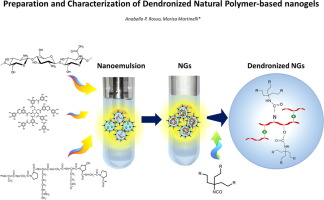当前位置:
X-MOL 学术
›
Eur. Polym. J.
›
论文详情
Our official English website, www.x-mol.net, welcomes your
feedback! (Note: you will need to create a separate account there.)
Preparation and Characterization of Dendronized Chitosan/Gelatin-based Nanogels
European Polymer Journal ( IF 5.8 ) Pub Date : 2020-02-01 , DOI: 10.1016/j.eurpolymj.2020.109506 Anabella P. Rosso , Marisa Martinelli
European Polymer Journal ( IF 5.8 ) Pub Date : 2020-02-01 , DOI: 10.1016/j.eurpolymj.2020.109506 Anabella P. Rosso , Marisa Martinelli

|
Abstract The composition, functionality and morphological structure of biomaterials control their properties, such as the hydrophilic/hydrophobic character, the magnitude of the inter/intramolecular interaction, and architecture and size, which determine their potential applications. The adequate combination of nanoscale with natural polymers could then yield nanogels (NGs) with greater relevance for biomedicine. Also, the dendritic structures can be combined with NGs to improve their applications. Then, the dendronized NGs combine the advantages of hydrogels, the nanoscale and multifunctionality, generating composite materials with synergic properties. Dendronized natural polymer-based NGs were prepared by inverse nanoemulsion. Gelatin and chitosan were crosslinked with 0.3, 0.6 and 0.9 wt% of tannic acid, and dendronized with weisisocyanate dendron. The NGs were characterized using infrared microscopy, thermogravimetric analysis and dynamic light scattering. IR spectra and thermic analysis allowed confirming the crosslinking reaction with tannic acid and dendronization of NGs. The systems are sized in the nanometric scale within 100 and 500 nm, and polydispersity index (PDI) values between 0.2 and 0.5. In all cases, an increase in the hydrodynamic diameter of the NGs was observed with the increase in the degree of crosslinking and a reduction in size after dendronization of up to 100 nm. NGs with low polydispersity were obtained, showing a hydrodynamic diameter value regulated by the crosslinker percentage, and an hydrophilic/hydrophobic character governed by the dendritic moiety.
中文翻译:

树枝状壳聚糖/明胶基纳米凝胶的制备和表征
摘要 生物材料的组成、功能和形态结构控制着它们的性质,如亲水/疏水特性、分子间/分子内相互作用的大小以及结构和尺寸,决定了它们的潜在应用。纳米尺度与天然聚合物的充分结合可以产生与生物医学更相关的纳米凝胶(NG)。此外,树枝状结构可以与 NG 结合以改善其应用。然后,树枝化的 NGs 结合了水凝胶、纳米级和多功能性的优点,产生了具有协同性能的复合材料。通过反相纳米乳液制备树枝状天然聚合物基 NG。明胶和壳聚糖与 0.3、0.6 和 0.9 wt% 的单宁酸交联,并用异氰酸酯树枝状树枝化。NGs 使用红外显微镜、热重分析和动态光散射进行表征。IR 光谱和热分析允许确认与单宁酸的交联反应和 NG 的树枝化。该系统的纳米级尺寸在 100 到 500 nm 之间,多分散指数 (PDI) 值在 0.2 到 0.5 之间。在所有情况下,随着交联度的增加和树枝化后尺寸减小至 100 nm,观察到 NGs 的流体动力学直径增加。获得了具有低多分散性的 NG,显示出由交联剂百分比调节的流体动力学直径值,以及由树枝状部分控制的亲水/疏水特性。热重分析和动态光散射。IR 光谱和热分析允许确认与单宁酸的交联反应和 NG 的树枝化。该系统的纳米级尺寸在 100 到 500 nm 之间,多分散指数 (PDI) 值在 0.2 到 0.5 之间。在所有情况下,随着交联度的增加和树枝化后尺寸减小至 100 nm,观察到 NGs 的流体动力学直径增加。获得了具有低多分散性的 NG,显示出由交联剂百分比调节的流体动力学直径值,以及由树枝状部分控制的亲水/疏水特性。热重分析和动态光散射。IR 光谱和热分析允许确认与单宁酸的交联反应和 NG 的树枝化。该系统的纳米级尺寸在 100 到 500 nm 之间,多分散指数 (PDI) 值在 0.2 到 0.5 之间。在所有情况下,随着交联度的增加和树枝化后尺寸减小至 100 nm,观察到 NGs 的流体动力学直径增加。获得了具有低多分散性的 NG,显示出由交联剂百分比调节的流体动力学直径值,以及由树枝状部分控制的亲水/疏水特性。该系统的纳米级尺寸在 100 到 500 nm 之间,多分散指数 (PDI) 值在 0.2 到 0.5 之间。在所有情况下,随着交联度的增加和树枝化后尺寸减小至 100 nm,观察到 NGs 的流体动力学直径增加。获得了具有低多分散性的 NG,显示出由交联剂百分比调节的流体动力学直径值,以及由树枝状部分控制的亲水/疏水特性。该系统的纳米级尺寸在 100 到 500 nm 之间,多分散指数 (PDI) 值在 0.2 到 0.5 之间。在所有情况下,随着交联度的增加和树枝化后尺寸减小至 100 nm,观察到 NGs 的流体动力学直径增加。获得了具有低多分散性的 NG,显示出由交联剂百分比调节的流体动力学直径值,以及由树枝状部分控制的亲水/疏水特性。
更新日期:2020-02-01
中文翻译:

树枝状壳聚糖/明胶基纳米凝胶的制备和表征
摘要 生物材料的组成、功能和形态结构控制着它们的性质,如亲水/疏水特性、分子间/分子内相互作用的大小以及结构和尺寸,决定了它们的潜在应用。纳米尺度与天然聚合物的充分结合可以产生与生物医学更相关的纳米凝胶(NG)。此外,树枝状结构可以与 NG 结合以改善其应用。然后,树枝化的 NGs 结合了水凝胶、纳米级和多功能性的优点,产生了具有协同性能的复合材料。通过反相纳米乳液制备树枝状天然聚合物基 NG。明胶和壳聚糖与 0.3、0.6 和 0.9 wt% 的单宁酸交联,并用异氰酸酯树枝状树枝化。NGs 使用红外显微镜、热重分析和动态光散射进行表征。IR 光谱和热分析允许确认与单宁酸的交联反应和 NG 的树枝化。该系统的纳米级尺寸在 100 到 500 nm 之间,多分散指数 (PDI) 值在 0.2 到 0.5 之间。在所有情况下,随着交联度的增加和树枝化后尺寸减小至 100 nm,观察到 NGs 的流体动力学直径增加。获得了具有低多分散性的 NG,显示出由交联剂百分比调节的流体动力学直径值,以及由树枝状部分控制的亲水/疏水特性。热重分析和动态光散射。IR 光谱和热分析允许确认与单宁酸的交联反应和 NG 的树枝化。该系统的纳米级尺寸在 100 到 500 nm 之间,多分散指数 (PDI) 值在 0.2 到 0.5 之间。在所有情况下,随着交联度的增加和树枝化后尺寸减小至 100 nm,观察到 NGs 的流体动力学直径增加。获得了具有低多分散性的 NG,显示出由交联剂百分比调节的流体动力学直径值,以及由树枝状部分控制的亲水/疏水特性。热重分析和动态光散射。IR 光谱和热分析允许确认与单宁酸的交联反应和 NG 的树枝化。该系统的纳米级尺寸在 100 到 500 nm 之间,多分散指数 (PDI) 值在 0.2 到 0.5 之间。在所有情况下,随着交联度的增加和树枝化后尺寸减小至 100 nm,观察到 NGs 的流体动力学直径增加。获得了具有低多分散性的 NG,显示出由交联剂百分比调节的流体动力学直径值,以及由树枝状部分控制的亲水/疏水特性。该系统的纳米级尺寸在 100 到 500 nm 之间,多分散指数 (PDI) 值在 0.2 到 0.5 之间。在所有情况下,随着交联度的增加和树枝化后尺寸减小至 100 nm,观察到 NGs 的流体动力学直径增加。获得了具有低多分散性的 NG,显示出由交联剂百分比调节的流体动力学直径值,以及由树枝状部分控制的亲水/疏水特性。该系统的纳米级尺寸在 100 到 500 nm 之间,多分散指数 (PDI) 值在 0.2 到 0.5 之间。在所有情况下,随着交联度的增加和树枝化后尺寸减小至 100 nm,观察到 NGs 的流体动力学直径增加。获得了具有低多分散性的 NG,显示出由交联剂百分比调节的流体动力学直径值,以及由树枝状部分控制的亲水/疏水特性。











































 京公网安备 11010802027423号
京公网安备 11010802027423号